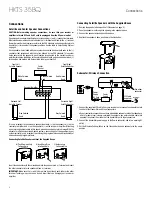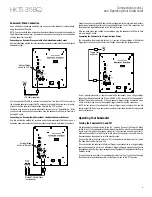
HKTS 35BQ
8
Connections
Connections
Satellite and Center Speaker Connections
CAUTION: Before making speaker connections, be sure that your receiver or
amplifier is turned OFF and its AC cord is unplugged from the AC power outlet.
Speakers and receivers/amplifiers have corresponding (+) and (–) connection terminals.
Most electronics makers use red to denote the (+) terminal and black for the (–) terminal.
Newer Harman Kardon receivers conform to the CEA standard and use specific colors to
denote the (+) terminals of the speaker positions. See the table in
Color-Coding System,
on page 4.
Each speaker wire included with your system has colored bands at both ends of the (+)
conductor that correspond with the colors defined by the CEA standard. This system
helps ensure that the speaker in each location is connected to the correct receiver or
amplifier terminals. In addition to the colored bands at each end, each speaker wire’s (+)
terminal has ribs molded into its insulation to help you identify it.
FRONT
LEFT
FRONT
RIGHT
CENTER
SURROUND
LEFT
SURROUND
RIGHT
Front Left
Satellite Speaker
Surround Left
Satellite Speaker
Receiver/Amplifier
White Colored
Band
Blue Colored
Band
Green Colored
Band
Red Colored
Band
Gray Colored
Band
Center
Speaker
Front Right
Satellite Speaker
Surround Right
Satellite Speaker
It is very important to connect each speaker identically: (+) on the speaker to (+) on the
receiver or amplifier, and (–) on the speaker to (–) on the receiver or amplifier. Miswiring
one or more speakers results in thin sound, weak bass and a poor stereo image. With the
advent of multichannel surround-sound systems, connecting all of the speakers in your
system correctly is very important to achieving the proper ambience and directionality of
surround-sound program material.
Connecting Satellite Speakers without the Supplied Bases
+
–
A) Push Down on Cap
to Open Hole
B) Insert Bare Wire
into Open Hole
C) Release Cap
to Secure Wire
Insert the conductor with the colored band into the speaker’s red (+) terminal, and insert
the other conductor into the speaker’s black (–) terminal.
IMPORTANT:
Make sure the (+) and (–) bare wires do not touch each other or the other
terminal. Touching wires can cause a short circuit that can damage your receiver or
amplifier.
Connecting Satellite Speakers with the Supplied Bases
1. Remove the speaker’s base (see
Shelf Placement,
on page 5).
2. Pass the speaker wire through the opening in the speaker’s base.
3. Connect the speaker wires as described above.
4. Reattach the speaker’s base, as shown in the illustration.
Subwoofer: Wireless Connection
1
2
WIRELESS
CODE
DC 5V
INPUT
R
3 4
L
SUBWOOFER/
LFE OUT
Power
Supply
AC Cord
Power
Supply
Use either
connector
LFE Cable
(supplied)
1. Connect the supplied LFE cable from your receiver’s or processor’s subwoofer output
to either of the transmitter unit’s Input connectors.
• If your receiver/processor does not have a dedicated subwoofer output but does have
a set of preamp-level (volume-controlled) line outputs, use a stereo audio cable (not
supplied) to connect them to both of the transmitter unit’s Input connectors
2. Connect the transmitter power supply to the Power connector, and into a working AC
outlet,
3. Set the Wireless Code switches on the transmitter unit and subwoofer to the same
position.






























